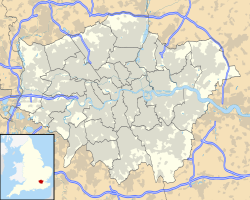City Canal
Location of the City Canal in Greater London |

The City Canal or Isle of Dogs Canal was a briefly used canal that led through the Isle of Dogs in London's East End and connected two stretches of the Thames , the Blackwall Reach and the Limehouse Reach . Today it has been completely rebuilt. It forms the southern part of the West India Docks and is known as the South Dock.
history
The West India Dock Act of 1799 enabled the City of London Corporation to build a canal from Limehouse Reach to Blackwall Reach via the Isle of Dogs. It was supposed to be an abbreviation for sailing ships that would otherwise have to sail around the southern tip of the Isle of Dogs to reach the upper stretches of the river. This trip could take a long time in poor winds. The canal was completed in 1805 (officially opened on December 9, 1805) and also included the Breach Dockyard at its western end , a large dock for mast construction and woodwork around a straight basin. The canal, including the necessary land, cost £ 168,813.
But the access to the canal depended on the tide and the passage took a long time. This meant that the canal was not an economic success as the shipowners were not paying enough fees. It soon became a financial burden and was sold to West India Dock Company , owner of West India Docks, in 1829 for £ 120,000 .
Society mainly bought the canal so that it would not fall into other hands. Proposals for additional docks south of the City Canal and the opening of the St. Katherine Docks in 1828 made the company's owners aware of the danger to their business posed by other docking plans. They built another woodwork dock south of the canal in 1832–1833. This should be the last major construction work on the docks for the next 20 years.
More than 30 years later (1866–1870), the canal was widened according to plans by civil engineer Sir John Hawkshaw , the entrances were expanded and the whole complex was renamed South West India Dock . It was later called the South Dock .
In 1926 it was decided that the South Dock should be connected to the import and export dock of the West India Docks, as well as to the Milwall Dock . The work - a new east lock for the South Dock and three passageways connecting Millwall Dock, South Dock, Export Dock and Import Dock - was split into four construction phases and completed in 1931 at the final price of £ 1,311,981, giving access Much improved to the docks.
today
The South Dock regularly hosts medium-sized warships that visit London as it is the furthest upstream point at which these ships can still turn thanks to the renovations carried out in 1926–1931. There is no longer any way for ships to cross the Isle of Dogs - only the converted eastern entrance to the docking facility remains.
Individual evidence
- ↑ Channels and their division
- ↑ London Thames Gateway Forum - Heritage ( Memento of the original from September 29, 2007 in the web archive archive.today ) Info: The archive link was automatically inserted and not yet checked. Please check the original and archive link according to the instructions and then remove this notice.
- ↑ a b c d From: The West India Docks: Historical development , Survey of London, volumes 43 and 44: Poplar, Blackwall and Isle of Dogs (1994), pp. 248-268
- ↑ West India Docks (1803–1980) (English) ( Memento of the original from September 26, 2007 in the Internet Archive ) Info: The archive link was inserted automatically and has not yet been checked. Please check the original and archive link according to the instructions and then remove this notice.
- ↑ a b Building the docks
Web links
- City Canal on London's Lost Rivers

